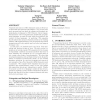Free Online Productivity Tools
i2Speak
i2Symbol
i2OCR
iTex2Img
iWeb2Print
iWeb2Shot
i2Type
iPdf2Split
iPdf2Merge
i2Bopomofo
i2Arabic
i2Style
i2Image
i2PDF
iLatex2Rtf
Sci2ools
SPAA
2009
ACM
2009
ACM
Towards transactional memory semantics for C++
Transactional memory (TM) eliminates many problems associated with lock-based synchronization. Over recent years, much progress has been made in software and hardware implementation techniques for TM. However, before transactional memory can be integrated into mainstream programming languages, we must precisely define its meaning in the context of these languages. In particular, TM semantics should address the advanced features present in the existing software TM implementations, such as interactions between transactions and locks, explicit user-level abort and support for legacy code. In this paper, we address these topics from both theoretical and practical points of view. We give precise formulations of several popular TM semantics for the domain of sequentially consistent executions and show that some of these semantics are equivalent for C++ programs that do not contain other forms of synchronization. We show that lock-based semantics, such as Single Global Lock Atomicity (SLA) o...
Disjoint Lock Atomicity | Global Lock Atomicity | Parallel Computing | Popular Tm Semantics | SPAA 2009 |
Related Content
| Added | 25 Nov 2009 |
| Updated | 25 Nov 2009 |
| Type | Conference |
| Year | 2009 |
| Where | SPAA |
| Authors | Tatiana Shpeisman, Ali-Reza Adl-Tabatabai, Robert Geva, Yang Ni, Adam Welc |
Comments (0)

